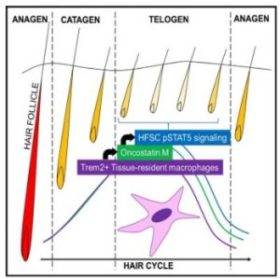
Over the past few years, I have discussed the janus kinase signal transducer and activator of transcription (JAK-STAT) signaling pathway a number of times. It has become of increasing importance in the hair loss world ever since JAK inhibitors were first shown to cure alopecia areata (AA) in 2014. Even prior to that development, there had always been some interest in the JAK-STAT signaling pathway and its relationship to the hair follicle cycle.
JAK-STAT Signaling Jump Starts the Hair Cycle
However, since 2014, research in this area seems to have multiplied significantly. In 2015, I discussed Dr. Angela Christiano, Dr. Claire Higgins et al’s groundbreaking paper titled “Pharmacologic inhibition of JAK-STAT signaling promotes hair growth”.
Now, in the latest (November 2016) issue of Journal of Investigative Dermatology, Columbia University’s Dr. Angela Christiano, Dr. Etienne Wang and Dr. Sivan Harel have published a new paper titled “JAK-STAT signaling jump starts the hair cycle“.
However, it should be noted that this paper does not pertain to any new study or research by Dr. Christiano. Instead, it is largely an analysis by the Columbia University team of a study/paper that was published earlier this year by Dr. Julien Legrand and his team at The University of Queensland.
This study from Australia was titled “STAT5 activation in the dermal papilla Is important for hair follicle growth phase Induction“. The conclusion of that paper was that “STAT5 activation acts as a mesenchymal switch to trigger natural anagen entry in postdevelopmental hair follicle cycling“. STAT5 is an acronym for signal transducer and activator of transcription 5.
Dr. Christiano’s team raises some interesting points in their analysis. Especially the fact that while Dr. Legrand’s research has shown that JAK/STAT5 signaling in the dermal papilla is required for anagen onset in the murine (mice) hair cycle, other researchers have shown that JAK inhibition is able to induce the transition of telogen to anagen in wild-type mice. This contradiction highlights the complexity and still yet to be fully understood nature of JAK-STAT signaling in the various stem cell niches of the hair follicle.
Dr. Christiano continues to believe that topical JAK inhibitors could work to treat regular male pattern hair loss. She thinks that targeting the JAK-STAT pathway could be a potential treatment for non-immune alopecias.
“Further work in this exciting area may uncover novel pathways that control hair follicle stem cell quiescence and activation. Targeting these pathways pharmacologically may facilitate the discovery of new therapies to treat various forms of alopecia”.
“In our recent study we found that in wild-type mice, topical application (rather than systemic treatment) with JAK inhibitors was required to trigger the telogen-to-anagen transition.”
This could possibky be due to a requirement for a high threshold level of local concentration of the drug in the hair follicle. The Columbia team also found that the timing of topical treatment was crucial. The treatment induced hair growth only if administered after 8.5 weeks (during late telogen phase).
Nothing groundbreaking in this development, but it seems like the University of Queensland based Australian team of researchers is important enough to warrant inclusion in my global map of hair loss research centers. One of the co-authors (Dr. Kiarash Khosrotehrani) of their paper specifically mentions research interest in “hair follicle biology, cycling and regeneration” in his biography page.